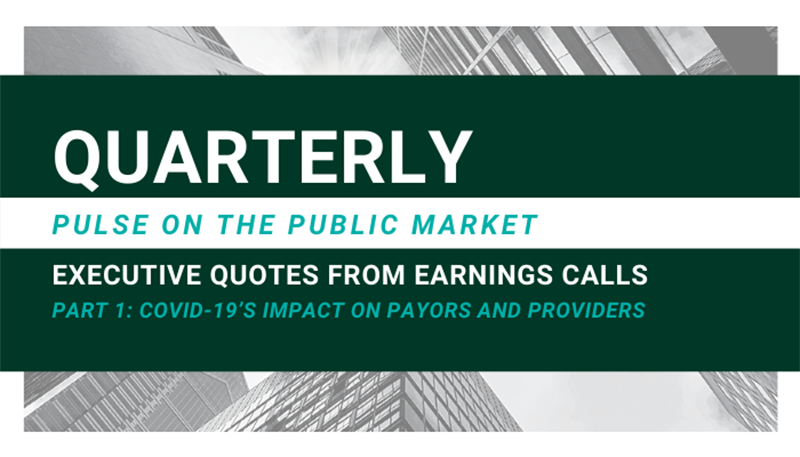
Contributors: Blake Madden, Spencer Coronado, Colin McDermott
Shelter-in-place orders and the suspension of elective procedures are impacting healthcare operations across the continuum of care. As healthcare demand dampens, the public health crisis has affected payors and providers in opposite ways.
Payors: ‘Historically Low’ Medical Costs
With decreased patient demand for healthcare services, payors benefit the most during the global pandemic. Despite the costs associated with treating COVID-19 patients, UnitedHealthcare expects its lowest medical loss ratio of the year during Q2 2020 due to suspension of elective procedures:
“And our quarterly progression will likely vary from historical patterns. For example, the environment today suggests the second quarter could be the lowest medical care ratio of the year, potentially meaningfully so with elective care demand still restrained. Offsetting this impact, we would anticipate the second half medical care ratio could be meaningfully elevated.”
“Among some of the factors we consider, people will hopefully have more comprehensive care access by the second half of the year and some of the currently deferred care can be restored. Individuals with chronic conditions are among those for whom we have considerable concern in this environment. While we are mitigating the impact through other means, missed treatments can aggravate health status, resulting in initially more intense care needs as the system reopens. We will proactively work to help them quickly seek care, and the impact of testing and coverage expansion, such as serologic tests. These are just a few of the factors we must consider, and I’m confident you are eager to probe into all of these areas and likely more.”
David Scott Wichmann (CEO & Director), UNH Q1 2020 Earnings Call (April 15, 2020)
While UnitedHealthcare noted low medical loss ratios in the first half of the year, the payor is expecting higher-than-normal medical costs in the second half of the year as pent-up demand for elective procedures returns. VMG Health will cover the expected recovery of patient volumes in Part 3 of this series.
Providers: Volumes in Decline
As payors experience historically low medical costs and minimally impacted operations, COVID-19 severely impacted providers across the spectrum of healthcare services during the first half of the year:
Hospitals
“The quarter really had 2 distinct periods to it: the pre-pandemic period, which was January 1 through March 15; and then the last half of March, where we began to see the impact of the COVID-19 pandemic.
“Almost all of our key volume indicators reflected growth through March 15 and contraction in the last half of March as compared to the prior year period. Same-facility emergency room visits grew about 5% through March 15 and declined close to 30% in the last half of March as compared to the prior year. Same-facility inpatient surgeries grew about 2% through March 15 and declined about 20% in the last half of March. Hospital-based outpatient surgeries grew about 2% through March 15 and declined about 30% in the last half of the month.”
William B. Rutherford (Executive VP & CFO), HCA Q1 2020 Earnings Call (April 21, 2020)
“Beginning in the middle of March, we experienced rapid declines in volumes due to the COVID-19 pandemic…inpatient admissions are down approximately 35%, adjusted admissions are down approximately 45%, surgery is down approximately 70% and ER visits down approximately 45%.”
Kevin J. Hammons (Executive VP & CFO), Community Health Systems Q1 2020 Earnings Call (April 29, 2020)
Imaging
“Our volumes hit a trough during mid-April, whereby we were down almost 85% on the East Coast and 65% on the West Coast relative to our original operating budget… our volumes have materially improved over the past several weeks, whereby our procedural volumes are down on a blended East and West Coast basis, about 40% as of today.”
Howard G. Berger (Chairman, President, CEO & Treasurer), RadNet Q1 2020 Earnings Call (May 11, 2020)
Home Health
“Our first signs of the COVID-19 impact began in the second week of March as we experienced an increase in missed visits and declines in referral volumes…All 3 lines of business witnessed similar trends. However, the disruption was greater in home health, which included a referral low point the week of April 5. Since that time, we have seen a steady recovery in referral volumes in all lines of businesses and a corresponding drop in missed visits.”
Paul Berthold Kusserow (Chairman, President & CEO), Amedisys Q1 2020 Earnings Call (May 7, 2020)
Outpatient Care
“USPI’s system-wide surgical cases saw over 50% in the back half of March and were down about 80% in April as we closed or scaled back capacity in all facilities.”
Ronald A. Rittenmeyer (Executive Chairman & CEO), Tenet Q1 2020 Earnings Call (May 5, 2020)
Post-Acute Care
“We believe it has been so clear and consistent that some individuals having strokes, heart attacks and other life-threatening medical emergencies have chosen and continue to choose not to call 911 or go to an acute care hospital for treatment due to fear of contracting the coronavirus. This has served to further lower census at acute care hospitals, and, in turn, has resulted in a decrease in our volumes.”
“The volume decline we experienced in the IRF segment in the back end of March and extending into April cut across virtually all patient conditions, and we believe it resulted from a number of factors. For conditions…nondiscretionary in nature, we believe there may have been a modest impact from patients choosing not to seek care, but the larger impact appears to stem from these patients remaining in the acute care setting. This was due both to the excess capacity created in many of these hospitals in our markets as they ceased performing elective surgeries, but did not experience a surge of COVID-19 patients, and patients choosing to forego post-acute inpatient care due to fear of COVID-19 exposure. Other patient conditions viewed as nondiscretionary and resulting from major trauma appear to have declined as a result of a reduction in accidents as much of the country is sheltered in place.”
Mark J. Tarr (CEO, President & Director), Encompass Q1 2020 Earnings Call (April 29, 2020)
Behavioral Health
“I think what we saw in the behavioral business was also to call it, the downstream effects from our referral sources. So when schools closed around the country, we definitely saw a decline in our adolescent business in a number of markets. We certainly saw a decline in outpatient revenues, which tend not to be quite as emergent. Outpatient treatment tends not to be quite as emergent. We’ve tried to replace a lot of that outpatient capacity with telemedicine.”
Steve G. Filton (Executive VP, CFO & Secretary), Universal Health Services Q1 2020 Earnings Call (April 28, 2020)
COVID-19 Devastated Healthcare Demand
Healthcare firms across all sectors experienced strong growth in patient volumes during what the operators described as the “Pre-COVID” term from January 1 through mid-March. However, once states mandated shelter-in-place orders and suspended elective procedures, providers reported an unprecedented drop in ER visit volume, outpatient visits, surgeries, admissions, and other services. COVID-19 dampened healthcare service demand across the continuum of care in a way that no economic recession has done so previously.
While payors experience historically low medical cost ratios during Q2, the largest unknown regarding healthcare demand centers around how much pent-up demand will be realized during the second half of 2020 and if there are fundamental changes in the way patients seek healthcare (i.e., telemedicine).





